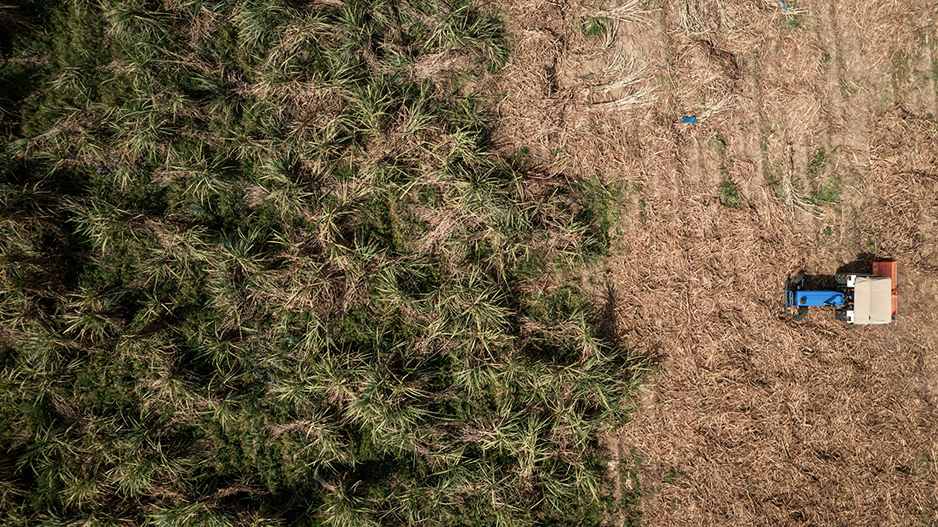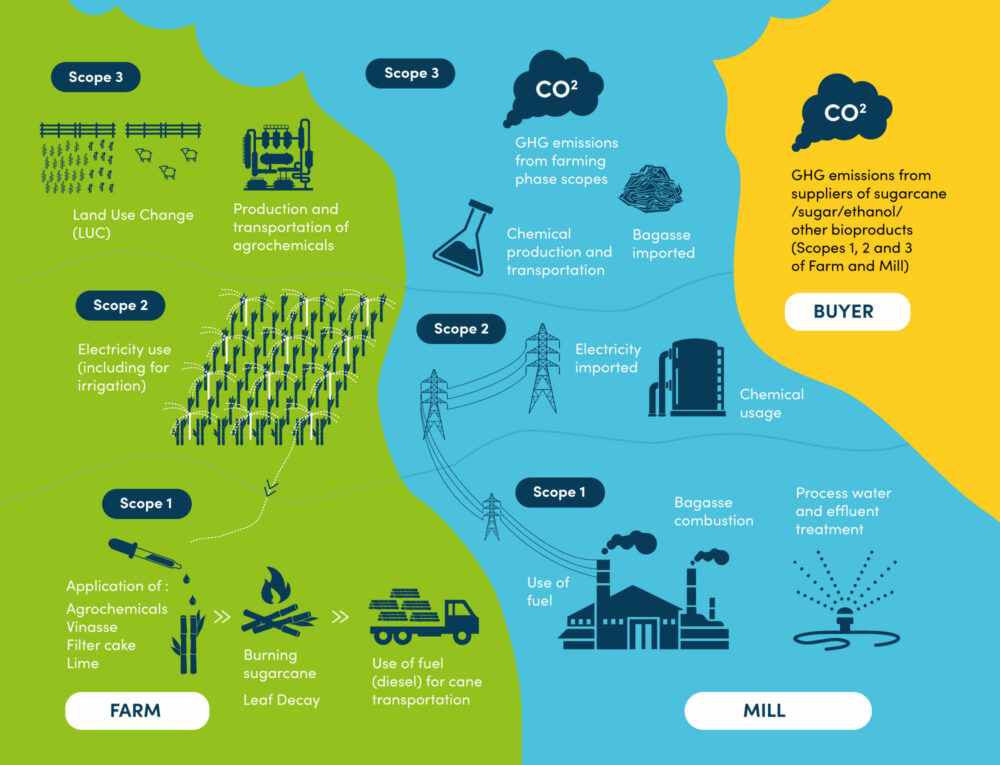10th November 2023

Bonsucro certified plantation, DCM Shriram, India, 2021
As we face an escalating climate crisis, greenhouse gas (GHG) mitigation has been at the forefront of climate action conversations. An increasing number of environmentally minded individuals are trying to curb their carbon footprints, while companies are setting targets for reducing their emissions.
In the sugarcane industry, recognising where these emissions originate is the first essential step. Let’s delve into the stages of the sugarcane value chain to identify where these emissions come from and some of the ways to reduce them.
Farming: the largest emitter
Agriculture and agroforestry together represent nearly a quarter of global GHG emissions. In the sugarcane value chain, farming is the biggest contributor, accounting for 400 million tons of CO2 equivalent annually.
A large part of emissions in sugarcane farming stems from the utilisation of machinery and agrochemicals, like fertilisers and pesticides. While enhancing productivity, these tools of modern agriculture also release considerable amounts of GHGs into the atmosphere.
Additionally, burning cane, a common method of clearing fields in some producing countries, further contributes to farming emissions. Other practices, like applying effluents to soil, irrigation, the decomposition of leaves, and changes in land use also play significant roles in these emissions.
Recognising those impacts, the imperative lies in adopting sustainable farming techniques and implementing better management practices.
Processing: an energy-intensive phase
Processing sugarcane, where the raw harvest transforms into materials such as sugar, molasses and ethanol, is undeniably an energy-hungry phase. According to our certification database, it accounts for an average of 23% of all GHG emissions of sugarcane production.
At the mill level, the main sources of GHG emissions are:
- Chemical inputs: vital for various stages of processing, they have a footprint associated with their production, transportation, and application.
- Water and effluents: processing and treating them require a lot of energy.
- Burning bagasse: a fibrous material left from crushing the cane, to generate energy for the processing plant.

GHG Emissions in the sugarcane value chain
Manufacturing sugarcane products
Whether it’s producing sugar-based confectioneries, ethanol for fuel or cosmetics, or packaging materials to replace virgin plastics, the manufacturing phase plays a vital role in the value chain. Emissions generated in farming and processing should be accounted for by manufacturers as Scope 3.
Reducing GHG emissions in sugarcane production
As a sustainability certification system and a platform for change, Bonsucro has helped identify and reduce emissions in the sugarcane sector for more than 10 years.
Using the Bonsucro Calculator, our members can track their environmental performance, including GHG emissions. The data is invaluable for climate action interventions, as it helps identify gaps and see exactly which areas need to improve. On a smaller scale, Bonsucro-certified smallholders use their Farm Diaries to monitor data on sources of GHG emissions, such as agrochemicals, water for irrigation, and transportation.
Once the sources of emissions have been identified, adopting more responsible practices to mitigate them is crucial. Such practices, covering areas like soil health, land use and agrochemicals, are covered in Bonsucro certification.
For instance, emissions from land conversion are prevented by certified producers, who protect areas of legally protected natural ecosystems, or areas classified as High Conservation Values, from conversion.
Soil acts as a carbon sink, locking in GHG; which means soil health plays an important role in mitigating emissions. The Bonsucro Standard requires producers to develop and implement a Soil Management Plan (SMP) to maintain and improve soil health. Beyond capturing GHG, healthier soils increase productivity, helping farmers get more out of less land and reducing the need for land conversion. Additionally, producers must maximise the efficiency of the agrochemicals to minimise the transport of input, soil pollution, and emissions.
Beyond reducing GHG emissions, protecting soils is vital to biodiversity. Soil is home to a rich variety of species; actually, one teaspoon of topsoil contains around 10,000 species.
 The latest version of our Production Standard (v5.2.) has a greater emphasis on continuous improvement and requires producers to have management plans based on the cycle of ‘plan, do, check and act’. This approach is expected across all areas of environmental performance, beyond GHG mitigation. It equips producers to better anticipate and prepare to changing factors, such as weather patterns, building their resilience.
The latest version of our Production Standard (v5.2.) has a greater emphasis on continuous improvement and requires producers to have management plans based on the cycle of ‘plan, do, check and act’. This approach is expected across all areas of environmental performance, beyond GHG mitigation. It equips producers to better anticipate and prepare to changing factors, such as weather patterns, building their resilience.
In 2020, a study using a sample of Bonsucro-certified mills and farmers in Brazil revealed a 31% reduction in GHG emissions at the farm level and 20% in mills over the first four years of certification. The same study showed that certification leads to reductions in water, fertiliser and herbicide use, and pre-harvest sugarcane burning.

Bonsucro impact data 2020
Sharing responsibility across the value chain
Reducing GHG emissions in sugarcane demands collaboration and transparency across the supply chain. While farms and mills bear the responsibility of complying with the Bonsucro Production Standard, it’s essential that they are supported by downstream companies, like traders, intermediaries, and end users.
By demanding and purchasing Bonsucro-certified sugar, ethanol, molasses, and other sugarcane-derived materials, companies invest in producers’ sustainability journeys and contribute to vital climate action in the sector, while lowering their own Scope 3 emissions.
Supporting GHG mitigation beyond certification
At Bonsucro, we support GHG mitigation in the sugarcane value chain beyond certification. Through the Bonsucro Impact Fund, we invest in collaborative, innovative and scalable projects in farming countries across themes including climate action. Buyers can invest in these projects too by purchasing Bonsucro Credits, which is the Fund’s main source of income.
Going further, and to help our members align their targets with science, we have just launched the ClimateCane Tracker, a practical tool designed to enable sugarcane farms and mills, and companies that source from them, to set targets and a clear pathway for reducing their emissions in line with science.
We look forward to supporting companies with their target setting soon and empowering the sector to play its part in addressing the climate emergency. Access the ClimateCane Tracker.




